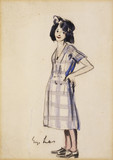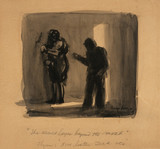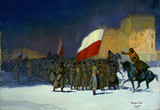George Benjamin Luks was one of the original Ash Can school painters whose scenes of lower-class city life upset conservative taste for propriety and genteel subject matter. Not many details of his life are known. He was quite a storyteller, and most of what is known about him derives from the myth that he cultivated about his own personality. He supposedly was boisterous, a hard drinker, and a braggart.
Luks studied at the Pennsylvania Academy of the Fine Arts in Philadelphia for only one month in 1884, but five years later he went abroad to study in Düsseldorf and Munich and to visit museums in Paris and London. He associated with the small group of artists who congregated around ROBERT HENRI in Philadelphia during the early 1890s and consequently became indoctrinated with Henri’s attitudes toward subject matter and technique.
Luks began his career as a newspaper illustrator, first working for the Philadelphia Press, then covering the SpanishAmerican War in Cuba for the Evening Bulletin. He later made illustrations for the New York World and Journal. At the Journal he drew the weekly comic page known as "The Yellow Kid." When his paintings began to sell he stopped working for newspapers. He moved to New York sometime during the late 1890s. In 1908 he participated in the landmark exhibition of The Eight at Macbeth Gallery that established the validity of the themes painted by the Henri circle.
Luks was known for his gutsy images of street life, in particular his figure paintings of beggars, urchins, and other colorful personalities, all painted in a dark palette and with energetically brushed, impastoed surfaces. He also painted landscapes and numerous portraits on commission-among his most famous is Otis Skinner as Colonel Bridau, 1919 (Phillips Collection, Washington, D.C.)-and he submitted drawings to the socialist weekly The Masses. In 1925 Luks spent two months in Williamsport, in the coal-mining region of Pennsylvania, drawing and painting coal miners. He taught at the Art Students League in New York from 1920 to 1924 and later organized his own school.
BIBLIOGRAPHY
Elisabeth Luther Cary, George Luks, American Artists Series (New York: Whitney Museum of American Art, 1931), with biographical note, bibliography § Newark (N.J.) Museum, Catalogue of an Exhibition of the Work of George Benjamin Luks, exh. cat., 1933, with biography § Index 20th Cent. Artists 1 (April 1934): 97-104; 1 (September 1934): ; 2 (September 1935): in; 3 (August-September 1936): v; reprint, pp. 139-46, 155, 157,159 § Utica, NY, Munson-Williams-Proctor Institute, George Luks, 1866-1933, exh. cat., 1973, with essays by Ira Glackens and Joseph S. Trovato § Wilkes-Barre, Pa., Wilkes College, Sordoni Art Gallery, and others, George Luks: An American Artist, exh. cat., 1987, with essays by Stanley L. Cuba, Nina Kasanof, and Judith O’Toole.



